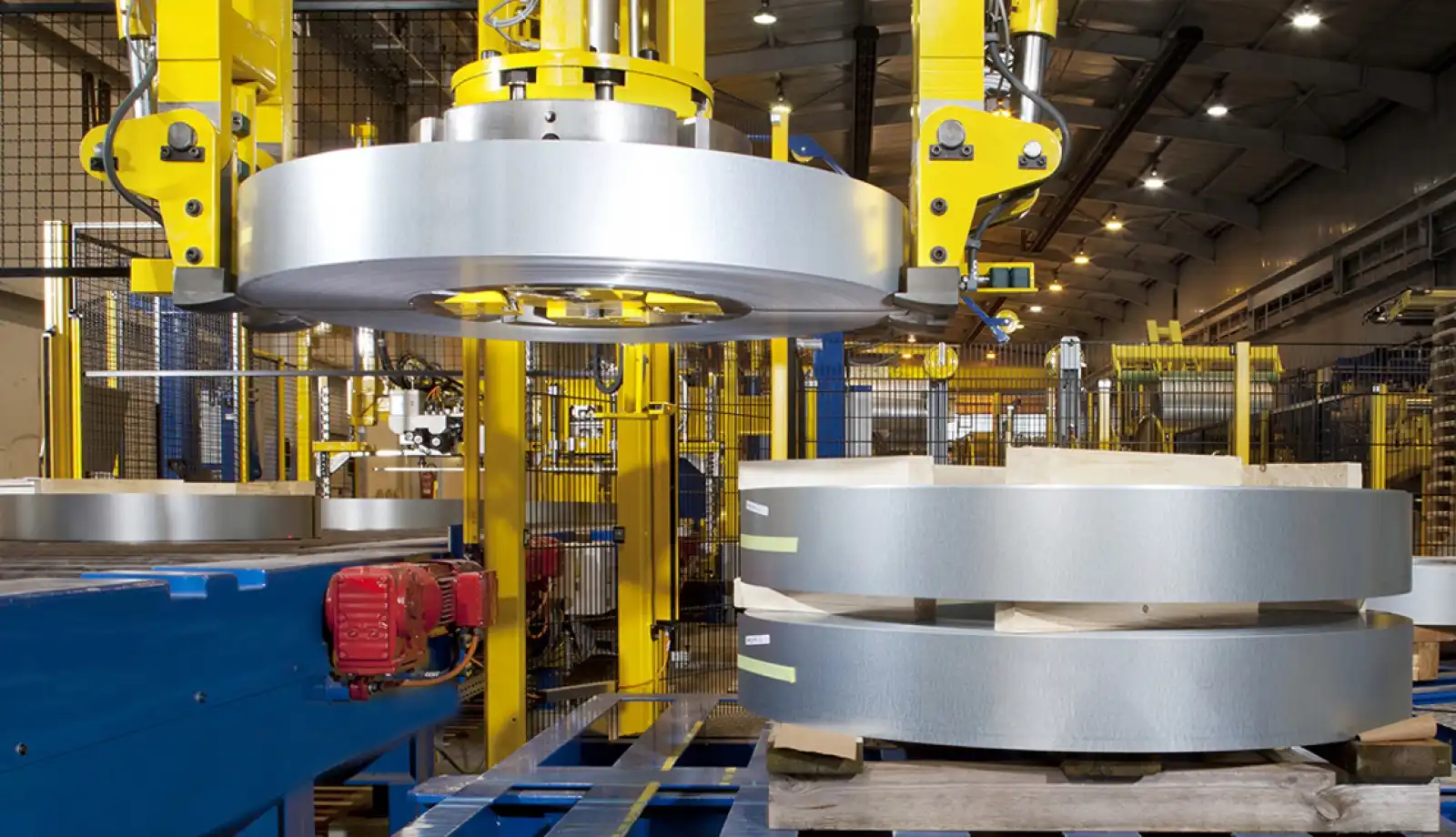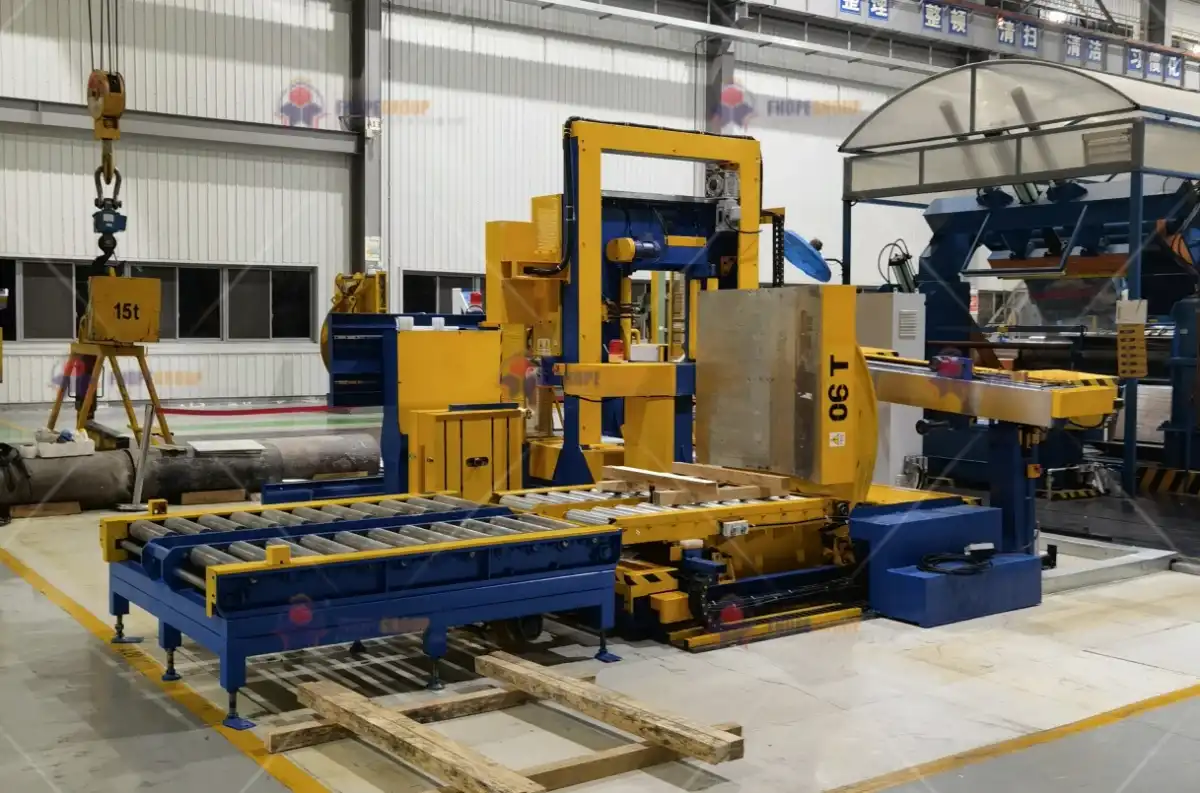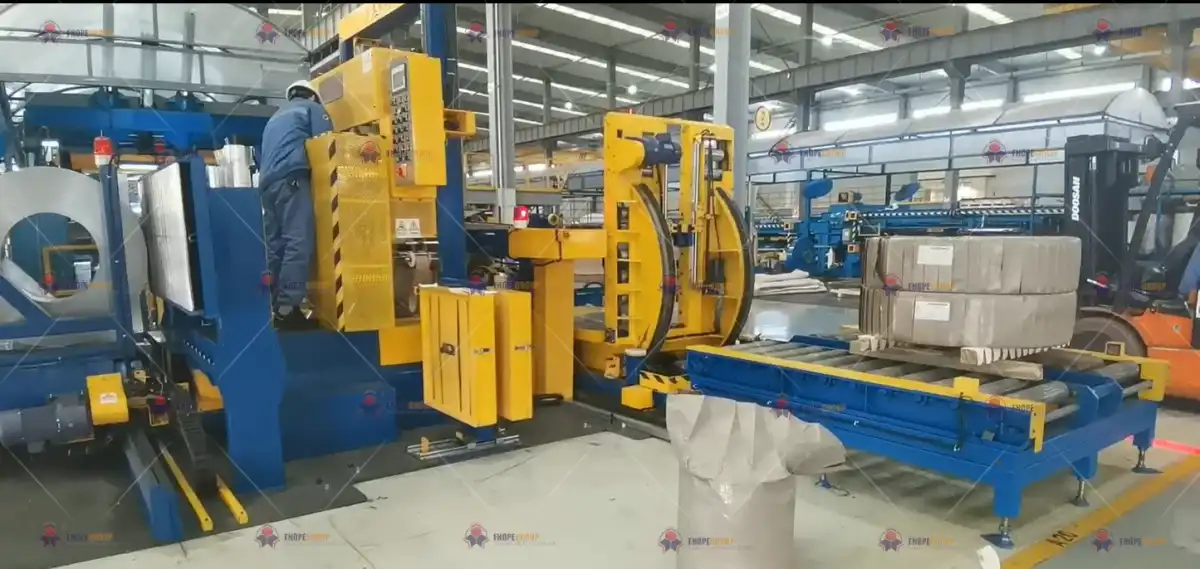Scratched coils, dented edges, and telescoping damage. These are not just minor operational headaches. They are silent profit killers in a steel plant. I've seen it myself. Early in my career, I watched a forklift operator accidentally puncture a high-value stainless steel coil. The cost of that single mistake was staggering. It included the lost material, the labor to handle it, and the potential damage to a client relationship. You might think your current process is good enough, but these small, recurring damages add up, eating away at your margins and directly challenging your goal to reduce overall operating costs. It’s a constant battle that many plant owners face. But what if there was a proven way to stop this bleeding? Across Latin America, particularly in Brazil, steel mills are fighting back with a powerful strategy, turning a major cost center into a competitive advantage.
Brazilian steel plants are solving the costly problem of coil damage by implementing fully automated coil handling and packaging lines. These systems minimize manual touchpoints, use precise, sensor-guided robotics for movement, and apply consistent, protective wrapping. This approach drastically reduces human error, which is the primary cause of scratches, dents, and improper packaging, directly preventing damage and preserving the value of the final product.

This solution is more than just buying a new machine. It represents a fundamental shift in how we approach the final, critical stage of steel production. For a leader like you, who analyzes every investment for its ROI and production stability, understanding the mechanics behind this shift is crucial. It’s not just about preventing damage; it’s about unlocking new levels of efficiency, data visibility, and cost control. Let's break down exactly how automation achieves this and what it could mean for your operations.
What specific types of coil damage does automation prevent?
You've worked hard to produce a perfect coil. It meets all quality specifications. Then, somewhere between the slitter and the shipping truck, damage occurs. A small scratch, a dented edge, or the beginning of rust from moisture. It feels avoidable, yet it keeps happening. This is a common frustration I hear from plant owners. They invest millions in production, only to lose value in the final hundred feet of the process. The problem is that manual handling, no matter how well-trained the crew, has inherent variability and risk. An operator has a bad day, a forklift tine slips, a coil is stacked incorrectly. The solution is to remove that variability by targeting the specific failure points where damage occurs.
Automation prevents the most common and costly types of coil damage—including surface scratches, edge dents, telescoping, and corrosion—by replacing inconsistent manual actions with precise, repeatable, and gentle robotic processes. Automated systems use sensor-guided clamps, controlled-speed conveyors, and perfectly tensioned wrapping to handle and protect the coil at every step, eliminating the risks associated with human error and rough handling.

Let's dive deeper into how this works. The goal here is to protect the asset you've already spent so much to create. It's about ensuring the quality you engineered is the quality the customer receives. An automated system is designed from the ground up to eliminate the root causes of damage. Instead of steel forklift tines, which can easily scratch or gouge a coil, an automated system uses coil cars and conveyors with non-marring surfaces. Lifting is done by specialized grabs that distribute pressure evenly, preventing dents.
When I was setting up my own factory, this was one of my first major investments. I had seen too much waste in my previous roles. We analyzed every touchpoint where a coil could be damaged and designed a process to mitigate it. The results were immediate. Our damage rate dropped by over 90% in the first year. This didn't just save us money on scrap; it improved our reputation. Customers knew that an order from us would arrive in perfect condition. That reliability is a powerful market differentiator.
Here is a more structured breakdown of how automation tackles specific damage types compared to manual methods:
Manual vs. Automated Handling: A Damage Prevention Analysis
| Damage Type | Manual Handling Risks | How Automation Solves It | Impact on Operations |
|---|---|---|---|
| Surface Scratches & Gouges | Forklift tines, dragging on rough floors, improper use of chains or hooks. Human error is high. | Uses smooth conveyors, coil cars, and soft-touch robotic clamps. No metal-on-metal contact. | Preserves surface finish, critical for automotive and appliance-grade steel. Reduces rework and scrap. |
| Edge Dents & Deformations | Rough setting down of coils, impact during transport, improper stacking. | Precise, sensor-guided placement. Coils are set down gently and perfectly aligned. Automated stackers ensure even weight distribution. | Maintains coil integrity for subsequent processing by the customer. Eliminates a major source of customer complaints. |
| Telescoping / Clock-Springing | Sudden starts/stops during transport, improper initial banding. | Smooth, controlled acceleration and deceleration on conveyors. Automated banding applies exact, consistent tension. | Ensures coil is tight and stable for safe transport and handling. Improves safety in the plant. |
| Corrosion & Water Staining | Inconsistent or incomplete wrapping with VCI paper/film. Gaps left for moisture to enter. | Automated wrapping machines apply materials with precise overlap and tension, creating a complete moisture barrier. | Guarantees product protection during storage and long-haul shipping. Extends shelf life and prevents rust claims. |
By addressing these issues systemically, you are not just patching a problem. You are building a more resilient, higher-quality production line. This directly contributes to your goal of lowering operational costs and increasing the effective use of your plant's capacity, as less time and material are wasted on damaged goods.
How does an automated packaging line integrate with existing production systems?
I understand the hesitation. You have equipment that has served you well for over 15 years. The idea of introducing a new, complex system can seem daunting. Will it communicate with my existing machinery? Will it create a new bottleneck? How steep is the learning curve for my team? These are the practical questions a CEO and engineer must ask. I've been there. When we were considering our first major automation upgrade, my biggest fear was the integration. A new machine is useless if it can't talk to the rest of the factory.
An automated packaging line integrates with existing production systems through a central PLC (Programmable Logic Controller) that communicates directly with your plant’s MES (Manufacturing Execution System) or ERP (Enterprise Resource Planning) software. Using a network of sensors, the line receives the coil ID and specifications from the slitter or crane, processes the coil, and then sends real-time data—like final weight, packaging used, and storage location—back to the central system, ensuring seamless data flow without manual entry.

Think of the automated line not as an isolated island, but as a smart hub in your production flow. This directly addresses your goal of digital transformation. It's about making your entire process visible and data-driven. When a coil leaves your slitting line, its journey begins. In a manual system, that journey is often tracked with paper, clipboards, and manual data entry—all points where errors can happen. An automated system makes this journey transparent.
Let’s trace the data flow. The moment a coil is ready, your MES can signal the automated line. A coil car or robotic crane is dispatched to pick it up. As the coil enters the packaging line, sensors and scanners confirm its identity, weight, and dimensions, cross-referencing this with the order data in your MES. The system then automatically selects the correct packaging recipe—the right type of paper, the number of wraps, the banding configuration—all based on customer requirements stored in your system. After the coil is packed and labeled, the system updates the MES, marking the coil as "ready for shipment" and assigning it to a specific location in the warehouse.
This level of integration brings several powerful advantages that align perfectly with your strategic goals:
Integration Benefits of an Automated Packaging Line
| Feature | How It Works | Impact on Your Goals |
|---|---|---|
| MES/ERP Communication | The line's PLC connects to your plant network. It can receive production orders and send back completion data via standard protocols (like OPC-UA or Ethernet/IP). | Drives Digital Transformation: Creates a single source of truth for production data. Enables the real-time, comprehensive production visibility you're targeting. |
| IoT Sensor Deployment | The system is equipped with sensors monitoring motor health, cycle times, material consumption, and other vital signs. This data is continuously collected. | Enables Predictive Maintenance: Moves you from reactive repairs to proactive maintenance, reducing downtime and helping achieve your 95% effective runtime target. |
| Automated Data Entry | Barcode scanners and RFID readers identify coils automatically. Scales are integrated into the conveyor line. Labels are printed and applied without human hands. | Reduces Human Error: Eliminates typos and incorrect data that can lead to shipping errors and inventory confusion. Lowers labor costs associated with manual tracking. |
| Smart Production Flow | The system acts as a buffer, smoothing the flow of material from production to warehousing. It can pace itself based on the output of the slitter. | Increases Capacity Utilization: Prevents bottlenecks that occur when manual packaging can't keep up with production, ensuring your primary assets are always running. |
I worked with a client in Brazil whose situation was very similar to yours. They had a highly productive rolling mill but their manual packing station was a constant bottleneck. Coils would pile up, waiting for packing. By integrating an automated line, they not only cleared the bottleneck but also gained perfect visibility into their finished goods inventory for the first time. Their plant manager told me it was like "turning the lights on" in a part of the factory that had always been a black box. This is the power of true integration.
What is the real ROI of an automated coil packing solution?
As a business owner, this is the most important question. A new automated line is a significant capital expenditure. You have to justify it, not with vague promises, but with hard numbers. You need to show your team and any financial partners that this investment will deliver a clear and compelling return, helping you achieve that target of lowering overall operating costs by 8% or more. The good news is that the ROI for this technology is one of the strongest in the industry, but it's calculated in ways that go far beyond simply replacing labor.
The real ROI of an automated coil packing solution is a composite of direct cost savings and significant efficiency gains. It comes from drastically reducing material waste from damaged coils, lowering direct and indirect labor costs, increasing throughput by eliminating bottlenecks, improving workplace safety, and reducing packaging material consumption. For most steel mills, the payback period on such an investment is typically between 18 and 36 months.

When I was building my own business, every dollar mattered. I learned to look at ROI from every angle. It’s not just about the obvious savings. It’s about the hidden costs you eliminate and the new opportunities you create. A damaged coil isn't just lost steel; it's lost machine time, wasted energy, administrative hours handling the complaint, and potential damage to your market reputation. Automation addresses all of these things at once.
Let's break down the components of the ROI calculation in a way that you can apply to your own 2-million-ton operation. A pragmatic, data-driven analysis is the only way to make a decision of this magnitude.
Calculating the ROI: A Multi-Factor Analysis
| ROI Component | How It's Calculated | Example Impact on a 2M Ton Mill |
|---|---|---|
| 1. Reduced Material Waste | (Damage Rate Reduction %) x (Annual Tonnage) x (Cost per Ton). A conservative estimate for manual handling damage is 0.5-1%. Automation can reduce this to <0.1%. | A 0.5% reduction in damage saves 10,000 tons of steel per year. At an average price, this can easily translate to millions of dollars in saved revenue. |
| 2. Labor Cost Savings | (Number of Workers per Shift) x (Shifts per Day) x (Annual Labor Cost per Worker). This includes salary, benefits, training, and turnover costs. | A typical manual line requires 3-5 workers per shift. An automated line requires 1 supervisor. This can save 8-12 positions' worth of costs annually. |
| 3. Increased Throughput | (New Packing Speed - Old Packing Speed) x (Operating Hours) x (Value per Ton). Automation is faster and runs 24/7 without breaks or fatigue. | If automation clears a bottleneck and allows the mill to produce and ship just 1% more finished product, that's an extra 20,000 tons of revenue per year. |
| 4. Packaging Material Optimization | (Manual Material Usage - Automated Material Usage) x (Number of Coils). Automated wrappers use the exact amount of film/paper required, eliminating over-wrapping. | Savings of 10-20% on packaging consumables are common. Across thousands of coils, this adds up to a significant direct cost reduction. |
| 5. Improved Safety & Reduced Insurance | Lowered incident rates (less forklift traffic, no manual lifting) can lead to reduced insurance premiums and lost-time costs. | This is a "soft" but important number. A single serious injury can cost hundreds of thousands in direct and indirect costs. Automation nearly eliminates these risks. |
When you add these factors together, the financial case becomes very clear. The investment stops looking like a cost and starts looking like a high-yield asset. It directly tackles your goals of reducing costs, improving throughput, and ultimately, boosting the overall profitability and stability of your plant. This is the kind of strategic investment that pays dividends for years to come.
How can automation address environmental and energy challenges in a steel mill?
Energy costs are volatile, and environmental regulations are only getting stricter. These are powerful external forces that can squeeze your profit margins. As a plant owner, you are constantly looking for ways to mitigate these risks. Investing in large-scale solutions like waste heat recovery is smart, but there are also significant gains to be made in your downstream processes. You need solutions that not only improve production but also contribute to your sustainability goals, like reducing unit product energy consumption by 10%.
Automation in coil packaging directly addresses environmental and energy challenges by incorporating high-efficiency components and optimizing processes. It utilizes modern, variable-speed motors that consume less power, minimizes the waste of packaging materials like plastic film and paper, and creates a smoother, more energy-efficient production flow, reducing the overall energy consumed per ton of steel shipped.

When I founded SHJLPACK, my engineering background pushed me to think about efficiency in every sense of the word. A well-designed machine shouldn't just be fast; it should be smart and responsible. We design our systems with this principle in mind. It's not just about compliance; it's about good engineering that also happens to be good for the environment and your bottom line. An old conveyor system with an oversized motor that runs at full speed all day is a constant energy drain. A modern, automated system is different.
It uses power intelligently. The motors on conveyors and wrappers are often equipped with Variable Frequency Drives (VFDs). This means they only draw the power needed for the task at hand, ramping up and down smoothly instead of running at 100% capacity all the time. The system can enter a low-power standby mode when no coils are present. These may seem like small details, but when added up over 24/7 operation, they make a real dent in your plant's overall electricity consumption.
This approach aligns perfectly with the forward-thinking strategy you've already demonstrated by investing in a smart scheduling platform and waste heat recovery. It's the next logical step in optimizing your entire operation.
Environmental & Energy Impact: Automation vs. Manual
| Challenge | Manual Process Issues | How Automation Improves It | Impact on Your Goals |
|---|---|---|---|
| Energy Consumption | Older equipment often uses oversized, inefficient motors that run constantly. Stop-and-go workflow is energy-intensive. | Uses high-efficiency motors with VFDs. "Sleep" modes reduce idle power draw. Smooth, continuous flow is more energy-efficient. | Directly contributes to your goal of a 10% reduction in unit energy consumption. Lowers your exposure to volatile electricity prices. |
| Material Waste | Manual wrapping leads to inconsistent overuse of VCI paper, stretch film, and banding. Damaged goods also become scrap material. | Automated wrappers apply the precise, pre-programmed amount of material for optimal protection with minimal waste. Reduced product damage means less scrap. | Reduces operational costs by lowering spending on consumables. Improves your environmental footprint by sending less waste to landfills. |
| Use of Consumables | Often relies heavily on disposable materials like large wooden pallets or excessive dunnage for protection. | Can be designed to use more sustainable or reusable solutions, such as minimal-waste packaging or integrated pallet-less systems. | Supports environmental compliance and can enhance your brand's reputation as a sustainable producer. |
| Operational Fluids | Older hydraulic systems can be prone to leaks, posing an environmental risk and requiring costly cleanup. | Modern systems are often all-electric, using servo motors that eliminate the need for hydraulic fluids, reducing environmental risk and maintenance. | Lowers maintenance costs and minimizes the risk of environmental fines or cleanup expenses. |
By adopting this technology, you are not just solving a packaging problem. You are making a strategic investment in a more efficient, sustainable, and cost-effective future for your steel mill. It's a solution that addresses the pressures of today while preparing your plant for the challenges of tomorrow.
Conclusion
Automating your coil handling isn't just an equipment upgrade; it's a strategic move for greater profitability, consistent quality, and future-proofing your plant against market pressures.





